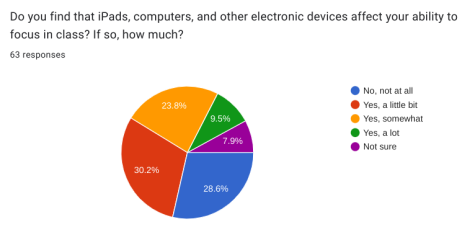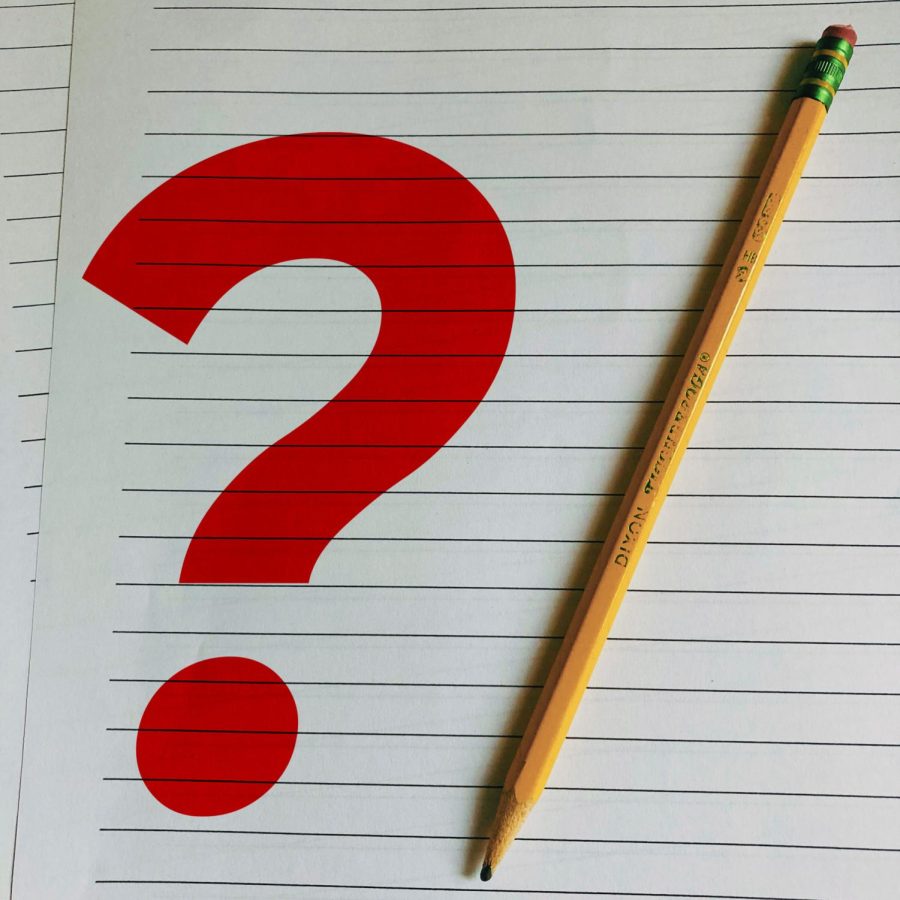The Future of Paper in the Classroom:
Pros and Cons of Going Paperless
One of today’s most controversial issues is the role of paper in society going forward. As concern about climate change has grown over the past years, many have seen moving away from paper as a way to protect the environment. In the aftermath of the COVID-19 pandemic, many students and teachers chose to use electronic devices instead of paper to combat deforestation. However, some teachers also argued that digitizing education affected students’ learning and therefore was counterproductive. In order to help myself and fellow students understand this controversial issue, I interviewed teachers and conducted a survey of the student body, listing the main pros and cons of going paperless in the classroom.
Pro #1: Organization and convenience
Several students surveyed said they felt like taking notes electronically was faster and that electronic notes were also easier to keep track of. Mrs. Eichler agreed with this, saying she allows students to use technology in her classroom because she knows it helps some of them to be more organized. Students also said they appreciated having electronic notes all in one place and not worrying about carrying around several notebooks and possibly losing or forgetting some at home.
Counterargument
While this is incredibly convenient, there is also a caveat: technology can malfunction or fail. For one, if the internet is down, a teacher is unable to access any of their lesson plans and materials. If a student’s electronic device malfunctions or stops working, they are unable to participate in classes or complete homework. Furthermore, if a student or teacher’s Google account is hacked, regardless of the security firewall, their files could be permanently lost.
Pro #2: Cost
Students surveyed expressed that they felt taking notes electronically instead of in a paper notebook and using online worksheets instead of printed worksheets was cheaper. One student surveyed said that Regina could use the money they save from not using paper to buy solar panels and other more sustainable materials for the school.
On the surface, paper does not seem that expensive–it usually costs between half a cent and two cents per sheet. However, if teachers use a paper-based curriculum, the costs of doing so start to accumulate rapidly. For example, if a teacher had three classes a day with twenty students in each class and gave each student three sheets of paper, that could cost anywhere between $0.90 and $3.60 per day. If the teacher did that each day for the whole year (assuming the year consists of 176 school days, given that is the Illinois state minimum of days in a school year), between $158.40 and $633.60 would be spent on paper. If every teacher at Regina did the same thing, between $3,960.00 and $15,840.00 would be spent on paper in a single year.
Counterargument
Technology has costs of its own–the more one uses it, the higher the probability of the device needing future repair, and such repairs can be costly. Furthermore, not all students can afford an electronic device, and it is extremely costly for public schools to provide every student with an electronic device. For example, for a public high school to provide an incoming freshman class of 500 students with 11.6-inch Lenovo IdeaPad 3 Chromebooks (about $100 each), it would cost $50,000. The average lifespan of a Chromebook is three to five years, so it’s debatable whether or not the incoming freshman class four years later would be able to use those Chromebooks. For private schools, however, much less money is spent on technology because students pay for their own electronic devices. Still, the cost of technology repairs on teachers’ electronic devices would accumulate over time (although it could still cost less than using paper in the classroom).
Pro #3: Better for the environment
The majority of scientists believe that reducing our usage of paper will help fight climate change. The reason for this is that the majority of people still use paper that has not been recycled, which causes billions of trees to be cut down every year. Trees are instrumental in combating climate change because they remove carbon dioxide from the atmosphere. Not only this, but trees are also important parts of ecosystems and many animals’ habitats. If paper ceases to be in such high demand, the number of trees cut down per year will lower significantly, protecting habitats and ecosystems and slowing climate change.
77.8% of Regina students surveyed also said they believed going paperless was better for the environment. Students who said they believed going paperless was better for the environment were asked to rate the importance of going paperless in helping the environment on a scale of 1 to 5, and the most common answer was 4 on a scale of 5 (answered by 42.3% of students surveyed).
Additionally, Mr. Stunkel, Mrs. Eichler, Mrs. Van Treese, and Mr. Doles all agreed that using less paper in the classroom was better for the environment. Out of all the teachers interviewed, Mr. Doles used the least amount of paper in his classroom. He said that during his first year of teaching, he used only paper; however, he then took home so much paper every night that he questioned the environmental impacts of using paper in class. Because of this, he soon went almost completely digital in his classroom.

Above: pie chart of survey result
Counterargument
Mrs. Eichler also said that while going paperless would be better for the environment, paper can also be recycled. One could argue that the problem is not that we use paper but that we continue to throw it away and produce products made from non-recycled paper. Using only recycled paper instead of virgin paper could also combat deforestation significantly.
Technology also may negatively impact the environment in other ways. For example, Mrs. Eichler said that ”running electronics requires an energy source, and unless the source is a clean energy source, there is an environmental impact of using technology.” Not only this, but many rare minerals—such as tungsten, lithium, and cobalt—are utilized to make electronic devices. Mining these materials often disrupts ecosystems and contaminates both air and soil. Furthermore, these materials are not sustainable—for example, scientists expect that, even if it is recycled, tungsten will run out by the year 2300. Going paperless in classrooms will increase the demand for electronic devices, causing further demand for these rare minerals. A possible solution to this problem would be recycling electronic devices, which companies such as Apple are starting to do; nevertheless, as mentioned above, the rare minerals used in technology will eventually run out.
Con #1: Technology can affect students’ ability to focus in class
One of the most widespread concerns about going paperless is its possible impact on students’ learning. Going paperless would require students and teachers to rely on technology in the classroom. Teachers are concerned that
Mrs. Eichler said technology “gives you access to so many things that it automatically splits attention,” and Mr. Stunkel said it is a “distraction in of itself” because “no matter what you’re viewing, it automatically shortens your attention span.” Mrs. Van Treese said that “we all fall prey to distractions” and that “if we’re not doing whatever we can to mitigate those distractions, we’re not setting them [students] up for success.” Additionally, 63.5% of Regina’s student body said electronic devices impact their ability to focus in some way, with 30.2% saying devices affected their ability to focus “a little bit,” 23.8% saying “somewhat,” and 9.5% saying “a lot.”

Above: Pie chart of survey results
Counterargument
While the majority of the students surveyed said electronic devices impacted their ability to focus in some way, a large portion said technology only affected their ability to focus “a little bit,” and another large portion (28.6%) said technology did not affect their ability to focus “at all.”
A further 7.9% said they were not sure. These statistics suggests that using technology in class impacts students differently; some students are not distracted by technology, and some who can manage that distraction.
Mr. Doles offered an alternative point of view. “Some students are distracted with or without devices,” he said.
Another idea is that some tablets mimic the experience of taking notes on paper, one being the ReMarkable 2. Since these tablets do not offer access to the internet, email, or text messaging, they could help students to take notes digitally without getting distracted. Furthermore, reusable notebooks such as the RocketBook could be another more environmentally friendly alternative to taking notes on paper.
Finally, several programs allow students to temporarily block sites to help them focus on tasks such as homework or schoolwork. Mr. Stunkel said he thinks that if programs such as these, as well as anti-cheating and anti-plagiarism software, were improved, the environmental benefits of going paperless would offset consequences in the classroom.
Con #2: Technology affects students’ ability to remember information learned
Studies have shown that there are many benefits to taking notes on paper in class. Scientists have found that brain activity increases when writing on physical paper versus writing with a stylus on an iPad or tablet. According to one study, the tactile sensations of writing on paper and the spatial makeup of a piece of paper stimulate the brain and allow students to remember information learned more effectively. Several students surveyed said they preferred paper notes because they allowed them to be more creative, take a break from technology, and remember information more easily.
Counterargument
As mentioned above, some tablets imitate the feel of paper and aim to provide similar memory benefits to paper note-taking, and there are also reusable notebooks. We should not ignore the memory benefits of paper note-taking but instead, find ways to recreate them while protecting the environment.
What do teachers think should be done?
The most common answer teachers gave was that we need to compromise between helping the environment and using paper when it benefits learning. In the words of Mr. Doles, we must find a balance between “reducing our paper footprint” and “doing what’s best for students.”

Mirai Silva '23 is a student reporting for the Crown. In her free time, she enjoys reading, writing, and crafting. Her favorite topics to write about are...



ella • Dec 14, 2022 at 10:06 pm
mr doles is so silly